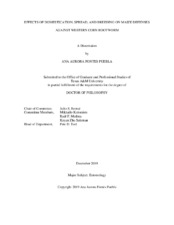| dc.description.abstract | This study addressed whether maize (Zea mays mays L.) defenses against Western corn rootworm (WCR), Diabrotica virgifera virgifera LeConte, were mediated by domestication, spread, and modern breeding, three transitions shaping the crop’s evolution. Trends of decreasing resistance to WCR with maize domestication, spread, and breeding, and of increasing tolerance with decreasing resistance were expected. Concomitant variation was expected in maize’s constitutive and induced phytohormone profiles, constitutive root volatile profiles, and recruitment of WCR larvae. To test these expectations, assays compared between four Zea plant types encompassing the three transitions: Balsas teosintes (Zea mays L. ssp. parviglumis), Mexican maize landraces, US maize landraces, and Mid-western US maize inbred lines. Specifically, the expected trends were tested by comparing between pairs of consecutive plant types: (i) resistance and tolerance to WCR; (ii) profiles of constitutive and induced levels of biochemical defenses, and; (iii) recruitment of WCR and profiles of constitutive root volatiles.
The results suggested that domestication and spread decreased both maize resistance to WCR as well as accumulation of biochemical compounds relevant to resistance to WCR, and increased recruitment of WCR and diversity of constitutive root volatiles, as expected. However, these trends were reversed with breeding, contrary to expected. The results also showed that maize resistance and tolerance to WCR are negatively correlated, as expected. Overall, my results suggested that evolution of defense strategies in maize, from the crop’s wild ancestor to modern Mid-western cultivars, is predicted by ecological-evolutionary hypotheses explaining defense strategy evolution in plants generally. I discussed my results in the contexts of plant resistance-productivity trade-offs, plant tolerance-resistance trade-offs, and varying resource availability in relation to physiological stress and herbivory pressure. | en |


